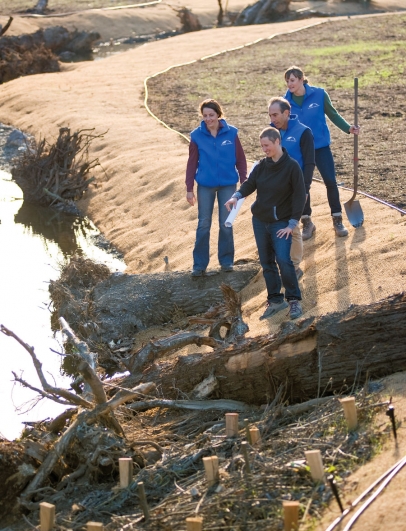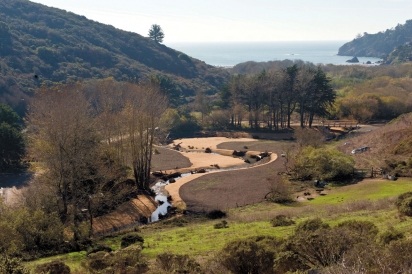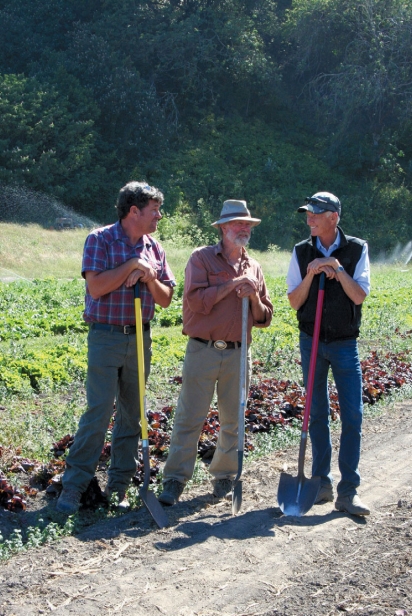Sustainable Conservation: Revving Up Restoration for Redds and Red-Legged Frogs
For those of us who love to spend time at Muir Beach, a lot has changed in the past few years. What used to be a confusing trudge down to the shore is now a peaceful walk over a wide bridge, with views of the meandering Redwood Creek on either side. Look east to follow the creek as it winds its way up into the mouth of the valley toward the Green Gulch Farm Zen Center (see story in our Fall 2013 issue), the embankments fortified with native sedges, rushes, ferns and young trees.
The restoration of Redwood Creek is emblematic of a new era of conservation in California. The increased ease of access and natural beauty—and the fact that the creek, which was straightened and channeled by a private landowner in the 1950s, is being restored to a natural state—is obvious at first glance. But what lies beneath the surface is what is most relevant to California’s future. This project re-created a riparian habitat critical to Coho salmon and steelhead, by removing barriers to fish passage, increasing stream shading and returning denuded streams to a more thickly wooded condition, which reduces sediment runoff and increases water conservation. This was possible only because a group of stakeholders—Green Gulch Farm, the County of Marin, NOAA Restoration Center, California Department of Fish and Wildlife, Marin Community Foundation, Natural Resources Conservation Service (part of the USDA) and private donors—found a common goal, an improvement that would benefit public, private, agricultural and environmental interests. Delving even further beneath the surface is the foundation for this success story: the policy and policy legislative work of the San Francisco–based nonprofit Sustainable Conservation.
In 2013, Sustainable Conservation, whose mission is to unite business, landowners and governmental agencies to solve the toughest problems facing our land, air and water, successfully urged the California Coastal Commission, which oversees land use along California’s more than 1,000-mile coastline, including that of the Green Gulch Farm, to approve a region-wide program to speed the implementation of voluntary habitat restoration projects in coastal areas. The decision currently benefits California’s coastal zone from the Oregon border through San Luis Obispo County.
The permitting process for conservation projects on private land in California has long been extremely complicated, time-consuming and expensive, an almost insurmountable challenge for private landowners, many of whom are farmers or vineyard owners working tirelessly day by day to respond to natural conditions and keep their businesses thriving. Although many of these people have the desire to do the right thing for the environment, few have had the financial resources, time or bureaucratic wherewithal to go through the hoops—sometimes seven or eight regulatory permits required—to initiate projects on their own land.
“That regulatory approval is where we come in,” says Ashley Boren, Sustainable Conservation’s executive director. “One half of California land is privately owned. As a state we rely on these landowners to take care of our environment. Sustainable Conservation wants to make it easy for them to do the right thing.”
The organization, funded by foundations, individual contributions and government grants, works with state and federal agencies to develop simplified approaches for permitting voluntary restoration projects. Pre-written “programmatic” permits save landowners time and money without sacrificing environmental protections. It also supports programs that provide technical and funding assistance from government and local conservation partners, so property owners can get projects designed and completed without emptying their own coffers.
In 1993, a group of environmentalists with extensive business experience founded Sustainable Conservation. “The organization was born out of the idea that gains for the environment would come when stakeholders figured out how to partner to find solutions that benefit California’s natural resources and California’s industry,” says Boren. The founders of Sustainable Conservation felt that too much time and goodwill was wasted in the maze of courtrooms and political obstacles. They posed a simple question: What if protecting the environment could also be good for business? This question, it turns out, received a resoundingly positive answer in the Northbay, where farmers have traditionally had a heightened understanding of their role as stewards of the land. The work of Sustainable Conservation and local conservation partners such as the Marin Resource Conservation District (RCD) has given agricultural interests the tools they needed to take action.
“Farmers and ranchers want to take on these projects,” says Nancy Scolari, Marin RCD executive director. “But many things need to come together. A rancher will look at a project, weigh it out, ask how much it will cost and what is the potential benefit? Sometimes a project will help them to manage their ranch better. Sustainable Conservation’s work has been fantastic, and allowed us to assist with more projects than ever before.”
Currently Scolari is managing two Marin County projects that benefit from Sustainable Conservation’s legwork: carbon sequestration plantings on the Straus Dairy and various riparian enhancement and water quality projects at Stemple Creek Ranch. “We want to do these projects. They are good for the land, and good for us,” says Lisa Poncia who runs Stemple Creek with her husband, Loren. “But it is not easy. It is a lot of work dealing with the government and the burden is on us. We have been able to do so many things we just wouldn’t be able to do without the support of these organizations.”
Also in Marin, a Bolinas project made possible by Sustainable Conservation groundwork and funded by a grant administered by the Marin RCD further exemplifies the possibilities of private-public partnership. Star Route Farms, Fresh Run Farms and Paradise Valley Farms—three organic farms that traditionally pulled water directly from Pine Gulch Creek—have voluntarily given up their summer water rights in order to protect the dwindling Coho population.
The farmers, with assistance from various conservation agencies, have built five diversion ponds. Water is pumped into the ponds from December to May. Then, in the dry months, the farms cease water diversion from the creekstream to protect the fish’s breeding grounds, the redds and pools where young fish thrive, which will boost salmon numbers. The California red-legged frog, which like the Coho is federally protected, also benefits from these ponds. This is made possible because in 2006 Sustainable Conservation developed a Safe Harbor Agreement with U.S. Fish and Wildlife so that the Endangered Species Act would not have the unintended side effect of restraining landowners as they pursue conservation projects such as this on private land.
Sound complicated? That is because it is. Each of these projects involves numerous regulating and funding agencies, not to mention bylaws that further complicate matters. Even if all parties involved have the same environmental goal, which they often do, projects can get caught in the legal weeds. Which is where Sustainable Conservation comes in to clear a path to doing the right thing. “In some cases we find the landowners are even taking the lead, ahead of conservationists, wanting to initiate projects,” says Valerie Minton of the Sonoma RCD. “So anything to improve the permitting process is a very good thing.”
The most recent significant Sustainable Conservation work comes in the form of Assembly Bill 2193, the Habitat Restoration and Enhancement Act, which passed unanimously in Sacramento in 2014. This bill focused on accelerating voluntary habitat restoration for the 350-plus animal and plant species in California that are currently considered endangered and under state and federal protection, and makes it easier for both private and public land managers to take action.
Thankfully, Sustainable Conservation’s impact is statewide. In 2004, Navarro Winery in Mendocino took advantage of a package of preapproved activity permits secured by Sustainable Conservation to protect fish habitat in a creek on their vineyard land. In the Central Valley, Sustainable Conservation has developed programs to help farmers implement low-impact “conservation tillage” cultivation practices to improve air quality and water management. And in Monterey and San Luis Obispo counties, permitting improvements are helping private landowners to conserve waterways critical to the health of the Central Coast ecosystems.
The group’s efforts to help restore salmon and streamside habitat on farmland in the Central Valley, limited until now to work in Yolo County, are expected to expand to other Central Valley farms in the near future.
Corte Madera’s Erik Schmidt is a senior conservation strategist for Sustainable Conservation who focuses on imperiled species and water quality. He has developed a big-picture, long-term view of conservation in our state.
“There are so many important things that need to happen. It is overwhelming to think about all of them. But then I think about the fact that it took 150 years to reach the point where we are today, so it is going to take a while to get things back. Piece by piece, step by step—it helps to think of things that way.”
Schmidt recently took his 6-year-old son to Muir Beach to volunteer at Redwood Creek, planting alders along the bank. “I look at the trees, the riparian forest, the meandering stream, and it’s a good feeling,” he says. “Hopefully someday it will be so lush and green that we will not know that it was ever any different.”








